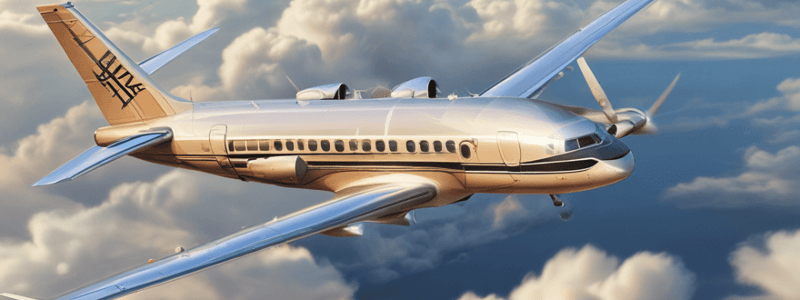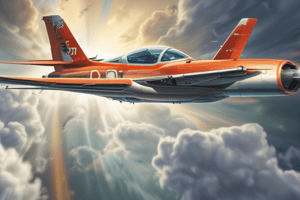Podcast
Questions and Answers
What is the primary purpose of maintaining engines in peak operating condition?
What is the primary purpose of maintaining engines in peak operating condition?
- To ensure the pilot's safety
- To improve the aircraft's appearance
- To prevent excessive fuel burn and increase fuel efficiency (correct)
- To reduce maintenance costs
What is the cost index used for in modern aircraft with a Flight Management System (FMS)?
What is the cost index used for in modern aircraft with a Flight Management System (FMS)?
- To determine the aircraft's maximum altitude
- To calculate the shortest flight route
- To monitor engine performance
- To balance fuel costs and time-related expenses (correct)
What is the benefit of a continuous descent approach (CDA)?
What is the benefit of a continuous descent approach (CDA)?
- It reduces the aircraft's altitude
- It increases air traffic control restrictions
- It increases the aircraft's speed
- It saves fuel by reducing time spent at lower altitudes (correct)
Why should pilots make in-flight adjustments?
Why should pilots make in-flight adjustments?
What should pilots consider when deciding whether to fly at higher speeds?
What should pilots consider when deciding whether to fly at higher speeds?
Why should the use of the Auxiliary Power Unit (APU) be minimized?
Why should the use of the Auxiliary Power Unit (APU) be minimized?
What is the primary purpose of the Flight Management System (FMS)?
What is the primary purpose of the Flight Management System (FMS)?
Why is it important for pilots to be familiar with their aircraft's recommended power settings?
Why is it important for pilots to be familiar with their aircraft's recommended power settings?
What is the result of flying at higher speeds?
What is the result of flying at higher speeds?
What is the benefit of using the cost index in modern aircraft?
What is the benefit of using the cost index in modern aircraft?
In flight planning, pilots should always plan for the shortest route, regardless of air traffic and weather conditions.
In flight planning, pilots should always plan for the shortest route, regardless of air traffic and weather conditions.
Removing necessary safety equipment can lead to significant fuel savings.
Removing necessary safety equipment can lead to significant fuel savings.
Flight planning should only consider the aircraft's performance characteristics and not the weight of the aircraft.
Flight planning should only consider the aircraft's performance characteristics and not the weight of the aircraft.
Maximizing fuel efficiency is only important for commercial pilots from an economic standpoint.
Maximizing fuel efficiency is only important for commercial pilots from an economic standpoint.
Pilots should always fly at higher speeds to reduce fuel consumption.
Pilots should always fly at higher speeds to reduce fuel consumption.
Evaluating air traffic and airspace restrictions is not important for fuel-efficient flight planning.
Evaluating air traffic and airspace restrictions is not important for fuel-efficient flight planning.
Wind conditions do not affect the aircraft's fuel burn rate during flight.
Wind conditions do not affect the aircraft's fuel burn rate during flight.
Pilots can ignore the weight of the aircraft during flight planning.
Pilots can ignore the weight of the aircraft during flight planning.
Fuel management involves only en-route flight planning and not pre-flight planning.
Fuel management involves only en-route flight planning and not pre-flight planning.
Reducing fuel consumption has no impact on environmental sustainability.
Reducing fuel consumption has no impact on environmental sustainability.
What is the primary goal of optimal flight planning in terms of fuel efficiency?
What is the primary goal of optimal flight planning in terms of fuel efficiency?
How does reducing the weight of the aircraft impact fuel consumption?
How does reducing the weight of the aircraft impact fuel consumption?
What factors should pilots consider when evaluating the most fuel-efficient routes?
What factors should pilots consider when evaluating the most fuel-efficient routes?
Why is it important to consider the weight of the aircraft during flight planning?
Why is it important to consider the weight of the aircraft during flight planning?
What is a key aspect of efficient fuel management during flight planning?
What is a key aspect of efficient fuel management during flight planning?
Why is maximizing fuel efficiency critical for commercial pilots?
Why is maximizing fuel efficiency critical for commercial pilots?
How does wind condition affect the aircraft's fuel burn rate during flight?
How does wind condition affect the aircraft's fuel burn rate during flight?
What is a benefit of evaluating air traffic and airspace restrictions during flight planning?
What is a benefit of evaluating air traffic and airspace restrictions during flight planning?
Why is it important to consider the aircraft's performance characteristics during flight planning?
Why is it important to consider the aircraft's performance characteristics during flight planning?
What should pilots prioritize when planning for fuel efficiency?
What should pilots prioritize when planning for fuel efficiency?
Flashcards are hidden until you start studying
Study Notes
Aircraft Performance: Jet vs Propeller Fuel Characteristics
- Fuel consumption is a critical aspect of aviation, directly impacting operating costs, flight range, and environmental footprint
- Jet engines and propeller-powered aircraft function on divergent principles
- Jet engines ingest air at high speeds, compressing it and mixing with fuel before igniting, generating thrust
- Propeller aircraft operate differently, with internal combustion engines converting fuel into mechanical energy, producing thrust
- Jet aircraft typically use Jet A, Jet A-1, or Jet B (kerosene-based fuels), while propeller aircraft may utilize avgas (aviation gasoline) or jet fuel
- Understanding fuel characteristics is essential for effective flight planning and operations
Aircraft Range Factors
- The Breguet range equation captures the relationship between fuel consumption and aircraft range, considering fuel efficiency, weight, and lift-to-drag ratio
- Weight plays a significant role in aircraft range, with increased weight requiring more fuel to maintain performance
- Aerodynamic efficiency, measured by lift-to-drag ratio, affects fuel consumption and range
- Fuel load management involves balancing fuel needs with weight considerations
- Engine performance characteristics, including efficiency at certain power settings and altitudes, impact range
- Cruise altitude affects fuel efficiency, with higher altitudes often providing better efficiency
- Weather conditions, including wind and temperature variations, influence aircraft range
- Operational practices, such as step climbing and route optimization, can enhance aircraft range
Maximizing Fuel Efficiency
- Efficient fuel management involves meticulous planning and understanding of aircraft performance characteristics
- Strategies for maximizing fuel efficiency include:
- Optimal flight planning, considering most fuel-efficient routes and altitudes
- Weight management, reducing unnecessary weight to save fuel
- Engine performance, maintaining engines in peak operating condition
- Use of cost index, balancing fuel costs and time-related expenses
- Efficient descent and approach, planning for continuous descent approaches
- In-flight adjustments, monitoring and adapting to changing flight conditions
- Speed adjustments, balancing speed with fuel efficiency
- Auxiliary Power Unit (APU) management, minimizing APU use when on the ground
Understanding Fuel Characteristics in Aircraft Performance
- Fuel consumption is a critical aspect of aviation, impacting operating costs, flight range, and environmental footprint.
- Jet engines and propeller-powered aircraft function on different principles:
- Jet engines ingest air, compress and mix with fuel, and generate thrust through the turbine.
- Propeller aircraft convert fuel into mechanical energy, which turns the propellers, producing thrust.
Fuel Types and Thrust Creation
- Jet aircraft typically use Jet A, Jet A-1, or Jet B (kerosene-based fuels).
- Propeller aircraft may utilize avgas (aviation gasoline) or jet fuel.
- Thrust creation:
- Jet engines produce thrust by expelling a high-speed jet of gas (Newton's third law).
- Propellers create aerodynamic lift, pulling or pushing the aircraft through air.
Factors Affecting Fuel Efficiency
- Altitude: Jet aircraft excel at high altitudes, where thin air reduces drag, making them more fuel-efficient.
- Speed: Turboprops are more efficient at lower altitudes and speeds, making them suitable for short-haul routes.
- Operational conditions: Jet aircraft are thirsty during takeoff and climb but settle into a more economical rhythm at cruising altitudes. Propeller-driven planes exhibit a more linear relationship with fuel consumption.
- Flight profiles:
- Jet aircraft are suitable for long-distance flights, where their high-altitude efficiency shines.
- Propeller aircraft are often used for short to medium-haul flights, where their lower-speed efficiency is advantageous.
Aircraft Range Factors
- Breguet range equation: A mathematical formula that captures the relationship between fuel consumption and aircraft range, considering fuel efficiency, weight, and lift-to-drag ratio.
- Weight: A significant factor in aircraft range, as increased weight requires more fuel to maintain performance. Weight management is crucial for optimizing flight plans.
- Aerodynamic efficiency: The lift-to-drag ratio affects fuel efficiency, with sleek, streamlined shapes contributing to better efficiency.
- Fuel load: A delicate balancing act between carrying enough fuel and minimizing weight.
- Engine performance characteristics: Understanding an engine's sweet spot can lead to significant fuel savings.
- Cruise altitude: Flying higher can improve fuel efficiency, but finding the optimal cruise level is crucial.
- Weather: Tailwinds can extend range, while headwinds and temperature variations affect air density and engine performance.
Strategies for Maximizing Fuel Efficiency
- Optimal flight planning: Evaluating air traffic, airspace restrictions, and weather conditions to identify the most fuel-efficient routes.
- Weight management: Reducing unnecessary weight to save fuel.
- Other strategies: Considering optimal altitudes, adjusting speed and power settings, and route optimization.
Understanding Fuel Characteristics in Aircraft Performance
- Fuel consumption is a critical aspect of aviation, impacting operating costs, flight range, and environmental footprint.
- Jet engines and propeller-powered aircraft function on different principles:
- Jet engines ingest air, compress and mix with fuel, and generate thrust through the turbine.
- Propeller aircraft convert fuel into mechanical energy, which turns the propellers, producing thrust.
Fuel Types and Thrust Creation
- Jet aircraft typically use Jet A, Jet A-1, or Jet B (kerosene-based fuels).
- Propeller aircraft may utilize avgas (aviation gasoline) or jet fuel.
- Thrust creation:
- Jet engines produce thrust by expelling a high-speed jet of gas (Newton's third law).
- Propellers create aerodynamic lift, pulling or pushing the aircraft through air.
Factors Affecting Fuel Efficiency
- Altitude: Jet aircraft excel at high altitudes, where thin air reduces drag, making them more fuel-efficient.
- Speed: Turboprops are more efficient at lower altitudes and speeds, making them suitable for short-haul routes.
- Operational conditions: Jet aircraft are thirsty during takeoff and climb but settle into a more economical rhythm at cruising altitudes. Propeller-driven planes exhibit a more linear relationship with fuel consumption.
- Flight profiles:
- Jet aircraft are suitable for long-distance flights, where their high-altitude efficiency shines.
- Propeller aircraft are often used for short to medium-haul flights, where their lower-speed efficiency is advantageous.
Aircraft Range Factors
- Breguet range equation: A mathematical formula that captures the relationship between fuel consumption and aircraft range, considering fuel efficiency, weight, and lift-to-drag ratio.
- Weight: A significant factor in aircraft range, as increased weight requires more fuel to maintain performance. Weight management is crucial for optimizing flight plans.
- Aerodynamic efficiency: The lift-to-drag ratio affects fuel efficiency, with sleek, streamlined shapes contributing to better efficiency.
- Fuel load: A delicate balancing act between carrying enough fuel and minimizing weight.
- Engine performance characteristics: Understanding an engine's sweet spot can lead to significant fuel savings.
- Cruise altitude: Flying higher can improve fuel efficiency, but finding the optimal cruise level is crucial.
- Weather: Tailwinds can extend range, while headwinds and temperature variations affect air density and engine performance.
Strategies for Maximizing Fuel Efficiency
- Optimal flight planning: Evaluating air traffic, airspace restrictions, and weather conditions to identify the most fuel-efficient routes.
- Weight management: Reducing unnecessary weight to save fuel.
- Other strategies: Considering optimal altitudes, adjusting speed and power settings, and route optimization.
Studying That Suits You
Use AI to generate personalized quizzes and flashcards to suit your learning preferences.




